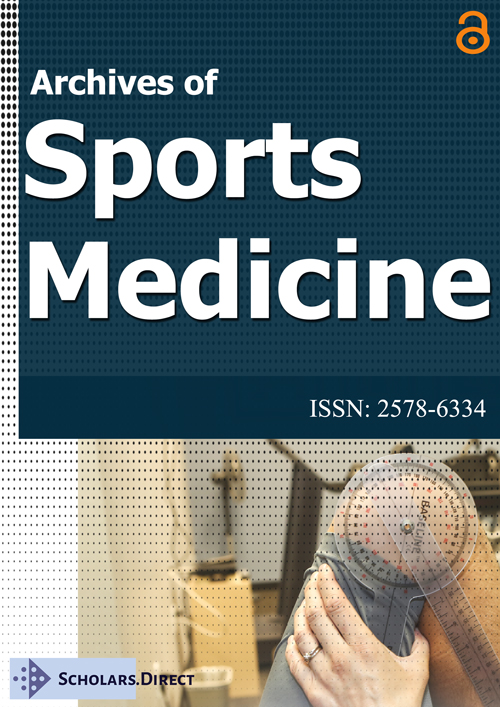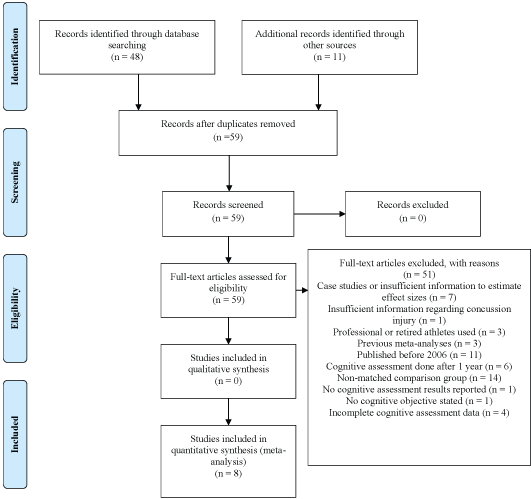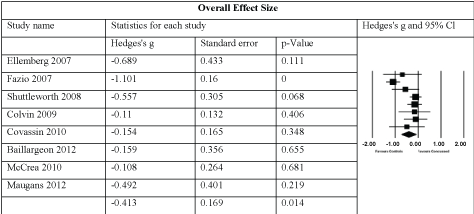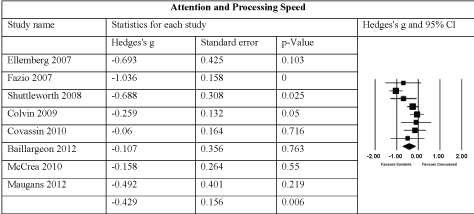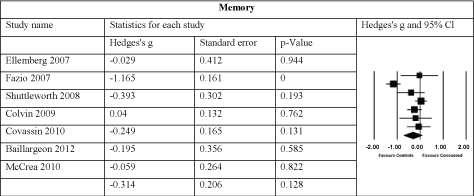The Long-Term Effects of Sport-related Concussions on Cognition in Interscholastic and Collegiate Athletes: A Meta-analysis of Cross-Sectional Studies
Abstract
Background
Over the past twenty years researchers have conducted cross sectional and longitudinal studies to examine how concussions could impact cognitive functions. Previous meta-analysis exploring the effect of a sport-related concussion on cognition lacked matched control groups and only assessed short-term effects ranging 7-14 days. There is increasing evidence and interest in examining the long term cognitive effects of concussions spanning over several weeks to months following the injury.
Objective
The purpose of this meta-analysis was to synthesize this concussion-cognition literature and determine the long term effects of concussion spanning 7 days up to 1 year post-injury.
Methods
A literature search was conducted to locate published cross-sectional studies on concussion and cognition in interscholastic and intercollegiate athletes. A total of eight studies published between August 2006 and May 2017 were included encompassing 915 athletes from 17 different sports. Neuropsychological assessments were conducted with these athletes after 7 days up to a year.
Results
We found 8 studies examining the effects of concussions on cognition in athletes. Using the CMA software the overall effect of concussion on cognition was significant when compared to athletes without a history of concussions (g = -0.413, p < 0.014). More specifically of the three cognitive domains, executive function (g = -0.645, p < 0.033) and attention and processing speed (g = -0.429, p < 0.006) showed significant effect sizes while memory (g = -0.314, p < 0.128) was not significant.
Conclusion
Our findings suggest that concussions not only have an acute negative impact on cognitive functions, but these effects can last up to a year post-injury affecting the executive function, attention and processing speed domains. We discuss the limitations of studies and implications for future research.
Keywords
Memory, Brain injury, Athletes, Executive function
Introduction
About 1.7 million Traumatic Brain Injuries (TBIs) occur every year in the United States of America [1]. Mild TBI's include symptoms such as a brief change in mental status, fogginess or headaches lasting no longer than 15 minutes. TBI's not only produce physical symptoms and disabilities but they can also cause cognitive complaints that affect neuropsychological performance of the brain across the domains of memory, attention and processing speed and executive functions. Executive functions include tasks such as planning, initiation, sequencing and goal directed behavior [2]. Attention and processing speed allows a person to sustain focus, concentrate and process information sufficiently [3]. Attention and processing speed can be broken down into different categories such as attention span [3], attention control [4], and sustained attention [4] and divided attention control [5]. Memory functions involve the ability to retain, recall and recognize information [6]. Taken together, each of these domains are important to perform activities of daily living.
Sport-related concussions are one example of a TBI and have become a major concern in both the neuropsychology and sports medicine literature over the past decade [7]. Similar to the definition of a TBI, a sport-specific concussion can also happen from a direct blow to the head or body that may cause the head to jerk or snap back and forth. Sport-related concussions have significantly increased in recent years for interscholastic and collegiate athletes, from 2001-2009 the number of reported cases involving sport-related concussions increased from 153,375 to 248,418 [8]. These statistics do not include the collegiate athletes who may or may not be treated by their athletic training/medical staff.
Outside of the immediate physical constraints and recovery related activity restrictions that sport-related concussions place on athletes the significance of the cognitive damage caused by these concussions are sporadically studied in these populations. Within the past nine years there have been three meta-analyses studying the cognitive performance of recently concussed college athletes. Belanger and VanderPloeg [9] conducted a meta-analysis assessing the effects of a sport concussion on cognition. They concluded that the cognitive domain mostly affected by a concussion was memory and was severely impaired 24 hours post-injury. They found that baseline functioning for memory returned by the 7th day post-concussion injury. Broglio and Puetz [10] conducted a meta-analysis assessing neuropsychological function, self-report concussion symptoms such as headache, nausea and postural control. The authors found that a sport-related concussion had a large negative effect on neurocognitive functioning, self-reported symptoms and postural control immediately after injury. There was a reduced but large negative effective size on all three variables 14 days post-injury. Belanger, Spiegel and Vanderploeg [11] conducted a meta-analysis assessing the impact multiple sport-related concussions have on neuropsychological performance. The authors found that sustaining multiple sport-related concussions (on average 2-3) did not have a significant impact on neuropsychological performance overall but did have minimal effect on memory and executive functioning.
The purpose of this meta-analysis was to review literature published after 2006 examining the relationship between concussions and the long-term effects on cognition in interscholastic and collegiate athletes. The decision to review literature published after 2006 was based on the referenced meta analyses [9,11] that cited literature published before 2006. The literature published before 2006 were already referenced in the above Meta analyses and would have been irrelevant to the current research study. Performing a meta-analysis for this study allows us to combine all of the included studies results to show a single conclusion with greater statistical power. Collectively past meta-analyses have shown that sport-related concussions are negatively related to cognitive performance in athletes [9-11]. These studies varied in participant selection, comparison groups, assessment times, and number of previous concussions sustained. Moreover, conclusions about long term effects of concussions on cognition cannot be drawn from these studies which mostly examine short term effects of the injury. Assessment times for past meta-analyses have ranged from 7-14 days post injuries which do not address post-acute or long-term effects on cognitive function. In the current analysis, short term (7 days), post-acute (30 days) and long term (longer than 30 days) effects were included. Including studies that have assorted time since injury allow us to show the varying impact that a concussion can have on cognition regardless of time lapsed. This is also crucial in showing why a pre-determined time since injury protocol is needed to provide consist measurement and diagnosis of concussions. In our review, we include studies that followed concussed athletes and control groups up to one-year post-injury. While some studies use a pre-post design with participants [12], this study includes research with non-concussed participants to show true baseline results, since some athletes may have already had more than one concussion. We examined the overall effect sizes for the individual studies as well as the effect sizes for specific domains of cognitive performance, including attention and processing speed, executive function, and memory.
Quorom
Literature search and study selection
The following databases were used to locate peer-reviewed studies from August 2006 to May 2017 that examined sport-related concussions and its effects on cognition in athletes: PSYCInfo, PubMed, JSTOR, National Institute of Health and Science Direct. The databases were checked on a weekly basis during a three-year period (January 2014 - May 2017). We used search terms that were constructed around three concepts-athletes, concussion and cognition - to identify all the relevant published articles investigating the concussion-cognition relationship. More specifically we used the following terms: college athletes, concussion, high school athletes, traumatic brain injury, memory, cognition, cognitive functioning, executive function, attention and processing. In addition to the online database search, reference lists of articles were also scanned to locate relevant literature.
Study inclusion criteria were: 1) Cross-sectional studies with both a concussed athlete group and a matched control group, with objective measures of cognition assessing at least one or more domains using paper-pencil or computer based measures, 2) Reported data that showed follow up cognitive tests between 7 days and one year post-concussion injury, 3) Participants with no prior sport-related head injuries, 4) A matched control group where participants were deemed healthy with no previous history of a concussion, 5) Cognitive assessment taking place up to one year post-concussion injury and 6) Sufficient cognitive data reported in the studies to estimate an effect size.
Study exclusion criteria were: 1) Meta-analysis, random controlled trials, longitudinal and other study designs that were not cross-sectional, 2) Studies lacking a matched control group, 3) Studies that did not measure cognitive functioning using objective assessments, 4) Studies lacking sufficient data to allow effect size calculations, 5) Studies that were conducted with samples other than athletes and 6) Studies published before August 2006 or up to May 2017. As the purpose of this meta-analysis was to examine the effect a sport-related concussion has on cognition, we included studies conducted with male and female youth, interscholastic and intercollegiate athletes, as long as they met these six inclusionary criteria.
Data abstraction and analysis
For each study, authors extracted the following details: sample size and mean age, gender of participants, sports studied, concussed/control group characteristics and guidelines used for concussion diagnosis. Cognitive tests used in all studies were classified into 3 categories: i) Attention and processing speed which is the sustained focus of cognitive resources, selective concentration and rapid processing of information [13], ii) Executive function which is a set of cognitive skills responsible for the planning, initiation, sequencing, and monitoring of complex, goal-directed behavior [14] and iii) Memory and working memory which involves retention, recollection, and recognition of previously encountered information [6]. Authors also extracted the following details regarding cognition characteristics from each study: name(s) of cognitive test(s), assessment time points post-injury and effect sizes.
Comprehensive Meta-Analysis software package [15] was used to conduct the analyses (BioStat, Englewood, New Jersey). Hedge's g [16] was calculated for each cognitive test reported in the articles. The majority of studies used multiple cognitive tests, often spanning each of the three cognitive domains. We therefore calculated: i) An overall effect size for each study and overall cognition and ii) An average effect size for each of the three cognitive domains. Study-specific effect size estimates were weighted by the study sample size and combined to form the overall study effect size. Forest plots were constructed to display study-specific overall effect sizes for each cognitive domain. All effect sizes were coded so that positive numbers always reflected improvements in performance, and negative numbers reflected deterioration in performance. A random effects analysis was conducted to provide a conservative estimate of concussion effects [17] and homogeneity of effects was assessed using the Q statistic.
Results
Selection
Figure 1 shows the flow of our literature search process. Our search generated a total of 59 references. Fifty one studies were excluded as they did not meet the following inclusionary criteria: case studies or insufficient information to estimate effect sizes, insufficient information regarding concussion injury, professional or retired athletes used as participants, previous meta-analyses studies published before August 2006, cognitive assessment done after one year, no healthy age-matched group for comparison, healthy age-matched group used for comparison but no cognitive data reported and no clear objective cognitive measure stated. Four other studies were excluded as they were missing cognitive assessment data to allow effect size estimations. Thus, a total of 8 studies [5,18-24] were retained for the meta-analysis, of which 5 were conducted in the US, 2 in Canada and 1 in South Africa.
Study characteristics
Table 1 shows the study characteristics for the eight studies included in this meta-analysis. Four studies used both male and female participants while three used only male participants and one study used only female participants. The American Academy of Neurology's definition of concussion was used for a diagnosis in five of the eight studies with one using the Immediate Post-Concussion Assessment Test (IMPACT) guidelines while one did not list any criterion for concussion diagnosis. The American Academy of Neurology defines concussion as "a condition resulting from the stunning, damaging, or shattering effects of a hard blow to the head." The AAN provides a concussion quick checklist to evaluate concussions immediately (www.aan.com/practice/sports-concussion-toolkit/). IMPACT is a computerized neurocognitive test that helps high schools; colleges/universities evaluate and manage concussions (www.impacttest.com/audience/?teams-1). The comparison groups in these studies included healthy, matched participants (gender, age, attending school and academic standing) that were a part of non-contact sports or no athletic affiliation at all. While the majority of the studies used athletes that participated in soccer, athletes participating in 17 different sports were represented in the studies reviewed. Other sports included football, basketball, wrestling and cricket. All of the participants were considered amateur athletes and did not have any prior experience playing on a professional level in their respective sport. Both the concussed and healthy groups were given baseline assessments before the start of their athletic season with follow up assessments conducted after a concussion.
Table 2 and Table 3 examine the cognitive characteristics of assessments used in the eight studies. The IMPACT testing was used more frequently (5 of the 8 studies) to determine cognitive performance for both the control and concussed groups. The assessment time points ranged from the day of injury up to one-year post-injury. Table 3 categorizes the cognitive tests used by study authors into the three domains of attention and processing speed, executive function and memory. The Simple Reaction Time (SRT) test used to assess attention and processing speed was the most commonly used measure in 4 of the 8 studies. Attention-processing speed and memory measures made up the largest pool of methods used (14 and 14 respectively) followed by executive function with six different measurements. For attention and processing speed, SRT (4) and motor processing speed (2) were the most frequently used measures. Trail making part A, Code substitution learning, Penn State University cancellation test (PSU) and symbol digit modality were also used for measuring attention and processing speed. Some of the executive function measures included Stroop, verbal fluency, trail making part B, tower of London, controlled oral word association and color trail-part 2. Fourteen different tests were used to evaluate memory (Table 3), some of them included the California verbal learning test immediate and delayed, Brown-Peterson test, Hopkins verbal learning delayed and visual and spatial memory tests.
Effect sizes
Overall effect sizes for all of the studies were calculated prior to examining specific cognitive domains. The overall effect size for all cognitive domains was significant g = -0.413, p < 0.014 (se = 0.169, 95% CI = -0.74 – -0.05, Q7 = 28.79, p < 0.001) as seen in Figure 2.
Attention and processing speed
All studies used cognitive tests that measured attention and processing speed. The effect size was significant with g = -0.429, p < 0.006 (se = 0.156, 95% CI = -0.73 – -0.12) as seen in Figure 3. There was however significant heterogeneity observed between the studies (Q7 = 24.36, p < 0.001).
Executive function
Three of the 8 studies examined the effects of concussions on executive function. The effect size was significant with g = -0.645, p < 0.033 (se = 0.303, 95% CI = -1.23 – -0.05) as seen in Figure 4. Each of the three studies showed similar results and there was no heterogeneity observed across the studies (Q2 = 4.09, p < 0.131).
Memory
Seven of the 8 studies used cognitive tests that measured memory. The effect size was not significant with g = -0.314, p < 0.128 (se = 0.206, 95% CI = -0.71 - 0.09) as seen in Figure 5. There was significant heterogeneity across the studies (Q6 = 36.91, p < 0.001).
Discussion
The purpose of this meta-analysis was to examine the overall effect sizes for the individual studies as well as the effect sizes for specific domains of cognitive performance including attention and processing speed, executive function and memory following a concussion. The overall effect size for all domains was -0.37 based on 8 studies, suggesting that sport-related concussions have a modest negative effect on cognition regardless of cognitive task, sex and sport played by the athlete. A closer examination of the three domains of cognition suggested specificity of effects. Attention and processing speed and executive function domains showed a significant negative effect whereas memory changes were not significantly affected among concussed athletes. These findings are different than those of past meta-analysis [9-11] where memory showed significant negative discrepancies after a sport-related concussion seven days post-injury.
The current meta-analysis provides new information regarding the effects of sport-related concussion on cognition, in particular on executive function and attention and processing speed domains. Executive function allows an individual to perform multiple tasks at once and has been associated with the frontal lobe of the brain [14]. Ellemberg, et al. [25] used brain imagery tools to systematically assess cognitive decline in previously concussed athletes. Ellemberg, et al. [25] also found that, using functional magnetic resonance imaging and Event-Related Potential (ERP), the areas of the brain that are susceptible to the effects of a sport-related concussion on cognition include the dorsolateral pre-frontal cortex, parietal and frontal cortex areas. They found that concussed athletes had lower amplitude and longer periods of latencies when using the ERP's to evaluate cognitive impairment and that decline in working memory was found in the dorsolateral prefrontal cortex while discrepancies in sequencing, an executive function task, was found in the parietal and lateral frontal area. These studies using imaging methods corroborate our findings where significant declines in executive function tasks were noted in concussed athletes.
Previous studies have found that the use of more difficult cognitive tasks when assessing a sport-related concussion on cognition when a person is asymptomatic will show larger deficits in domains such as executive function and attention and processing speed [26-28]. Ellemberg, et al. [25] found that 6-8 months after initial sport-related concussion those in the concussed group still scored significantly lower on cognitive tasks that measured planning time, inhibition speed and response time, all tasks that would be categorized as executive function or attention and processing speed. In other words, the damage from a sport-related concussion on high level cognitive tasks may still be present well after initial symptoms have conceded than previously reported [29]. This resonates with the findings and purpose of our meta-analysis to assess the effects of concussions on the cognitive health of athletes.
The current meta-analysis consists of studies that used participants from 17 different sports. While the majority of the studies focused on contact sports such as football, rugby, soccer and wrestling, other sports such as track and field, swimming and gymnastics known as non-contact sports were also sampled. The type of sport (contact vs. non-contact), the competition level (collegiate, interscholastic), the position played by the athlete within the sport and the type of protective equipment used while participating in the sport can all play a major role in an athlete receiving a sport-related concussion and its impact on physical and mental health [25,30-32]. However, further research is warranted before fully determining the influence the type of sport played has on an athlete possibly receiving a sport-specific concussion.
This meta-analyses is not without limitations. The small number of studies included makes it difficult to determine gender differences or sport specific declines in cognitive performance. Since all studies were cross-sectional, it is impossible to completely state that all cognitive deficits were a direct effect of the occurrence of a sports-related concussion. The studies examined used various cognitive assessments, sample populations, concussion and control group characteristics, lack of treatment description/medical treatment protocol and all symptoms regarding concussions were self-reported. Six out of the eight studies used participants in the concussed groups who already had previous concussions although they were asymptomatic at the time. The lack of a uniform assessment time point (pre-season vs. pre-game) and absence of true non-concussed baseline scores are two major limitations that should be addressed in future work. Researchers also need to determine the appropriate time points post-injury to conduct cognitive assessments and determine the trajectory of cognitive changes, as well as examine ways to find a true baseline when working with athletes who may or may not report previous concussion history. One crucial finding related to neurocognitive performance was the lack of standard cognitive measures used in this research. Each study included in this analysis used multiple assessment tools (up to 14 different measures of memory and attention-processing speed) to determine cognitive decline post-injury (seen in Table 3). There is a clear need for current and future researchers to collaborate, identify and employ established, standardized, reliable and valid neurocognitive tests to assess neurocognitive function.
Even with the limitations listed the findings provided by this meta-analysis are new and provide more insight into the effects of a sport-related concussion on cognition, particularly the executive function and attention-processing speed domains. The studies included in this analysis have assessment time points up to one year which gives researchers, athletic trainers, sport coaches, sport administrators and parents a better understanding of the enduring effects of a sport-related concussion on cognition. A major strength of this analysis is the inclusion of studies that used healthy comparison groups. The control groups were non-concussed healthy athletes in the same age group with a matched education level. This is strength because previous meta-analysis did not include a matched control group or a control group at all. Most of the studies used in previous meta-analyses explored the baseline and post-injury scores of only concussed athletes. Research examining cognitive performance after a sport-related concussion needs more specific cognitive assessments including advanced imaging methodologies. Future research should focus not only on identifying post-concussion cognitive declines but also how these can impact sport performance as well as quality of life of the athletes. Knowledge about long term effects of concussions on cognition will also allow researchers to design interventions to prevent further declines in cognitive health and mental well-being in at-risk athletes. We hope that this meta-analysis will serve as a significant platform for researchers to overcome past limitations and design and implement systematic research protocols to detect and possibly improve cognitive functioning in concussed athletes.
Conflict of Interest and Financial Disclosures
The authors have no conflict of interests and there are no financial disclosures.
References
- Faul M, Xu L, Wald MM, et al. (2010) Traumatic brain injury in the United States: emergency department visits, hospitalizations and deaths 2002-2006. Centers for Disease Control and Prevention, Atlanta, USA.
- McCrory P, Meeuwisse W, Johnston K, et al. (2009) Consensus statement on concussion in Sport 3rd International Conference on Concussion in Sport held in Zurich, November 2008. Clin J Sport Med 19: 185-200.
- Kirkwood MW, Yeates KO, Wilson PE (2006) Pediatric sport-related concussion: A review of the clinical management of an oft-neglected population. Pediatrics 117: 1359-1371.
- Van Zomeren AH, Brouwer WH (1994) Clinical neuropsychology of attention. Oxford University Press, New York.
- Baillargeon A, Lassonde M, Leclerc S, et al. (2012) Neuropsychological and neurophysiological assessment of sport concussion in children, adolescents and adults. Brain Inj 26: 211-220.
- Smith PJ, Blumenthal JA, Hoffman BM, et al. (2010) Aerobic exercise and neurocognitive performance: a meta-analytic review of randomized controlled trials. Psychosom Med 72: 239-252.
- Upshaw JE, Gosserand JK, Williams N, et al. (2012) Sports-related concussions. Pediatr Emerg Care 28: 926-932.
- Centers for Disease Control and Prevention (2011) Nonfatal traumatic brain injuries related to sports and recreation activities among persons aged ≤19 years - United States, 2001-2009. MMWR 60: 1337-1342.
- Belanger HG, Vanderploeg RD (2005) The neuropsychological impact of sports-related concussion: a meta-analysis. J Int Neuropsychol Soc 11: 345-357.
- Broglio SP, Puetz TW (2008) The effect of sport concussion on neurocognitive function, self-report symptoms and postural control. Sports Med 38: 53-67.
- Belanger HG, Spiegel E, Vanderploeg RD (2010) Nueropsychological performance following a history of multiple self-reported concussions: a meta-analysis. J Int Neuropsychol Soc 16: 262-267.
- Talavage TM, Nauman EA, Breedlove EL, et al. (2014) Functionally-detected cognitive impairment in high school football players without clinically-diagnosed concussion. J Neurotrauma 31: 327-338.
- Lezak MD, Howieson DB, Loring DW (2004) Neuropsychological Assessment. (4th edn), Oxford University Press, New York.
- Miyake A, Friedman NP, Emerson MJ, et al. (2000) The unity and diversity of executive functions and their contributions to complex "Frontal Lobe" tasks: a latent variable analysis. Cogn Psychol 41: 49-100.
- Borenstein M, Hedges L, Higgins J, et al. (2005) Comprehensive meta-analysis version 2. Englewood, NJ: Biostat, 104.
- Cohen J (1988) Statistical Power Analysis for the behavioral sciences. In: Mahwah, (2nd edn), Lawrence Erlbaum, New Jersey.
- Schmidt FL, Oh IS, Hayes TL (2009) Fixed‐versus random‐effects models in meta‐analysis: model properties and an empirical comparison of differences in results. Br J Math Stat Psychol 62: 97-128.
- Covassin T, Elbin RJ, Nakayama Y (2010) Tracking neurocognitive performance following concussion in high school athletes. Phys Sportsmed 38: 87-93.
- Ellemberg D, Leclerc S, Couture S, et al. (2007) Prolonged neuropsychological impairments following a first concussion in female university soccer athletes. Clin J Sport Med 17: 369-374.
- FazioVC, Lovell MR, Pardini JE, et al. (2007) The relation between post concussion symptoms and neurocognitive performance in concussed athletes. NeuroRehabilitation 22: 207-216.
- Maugans TA, Farley C, Altaye M, et al. (2012) Pediatric sports-related concussion produces cerebral blood flow alterations. Pediatrics 129: 28-37.
- McCrea M, Prichep L, Powell MR, et al. (2010) Acute effects and recovery after sport-related concussion: a neurocognitive and quantitative brain electrical activity study. J Head Trauma Rehabil 25: 283-292.
- Parker TM, Osternig LR, Van Donkelaar P, et al. (2007) Recovery of cognitive and dynamic motor function following concussion. Br J Sports Med 41: 868-873.
- Shuttleworth-Edwards AB, Smith I, Radloff SE (2008) Neurocognitive vulnerability amongst university rugby players versus noncontact sport controls. J Clin Exp Neuropsychol 30: 870-884.
- Ellemberg D, Henry LC, Macciocchi SN, et al. (2009) Advances in sport concussion assessment: from behavioral to brain imaging measures. J Neurotrauma 26: 2365-2382.
- Broglio SP, Moore RD, Hillman CH (2011) A history of sport-related concussion on event-related brain potential correlates of cognition. Int J Psychophysiol 82: 16-23.
- Broglio SP, Pontifex MB, O'Connor P, et al. (2009) The persistent effects of concussion on neuroelectric indices of attention. J Neurotrauma 26: 1463-1470.
- Gosselin N, Thériault M, Leclerc S, et al. (2006) Neurophysiological anomalies in symptomatic and asymptomatic concussed athletes. Neurosurgery 58: 1151-1161.
- Broglio SP, Macciocchi SN, Ferrara MS (2007) Neurocognitive performance of concussed athletes when symptom free. J Athl Train 42: 504-508.
- Bleiberg J, Cernich AN, Cameron K, et al. (2004) Duration of cognitive impairment after sports concussion. Neurosurgery 54: 1073-1078.
- Brainard LL, Beckwith JG, Chu JJ, et al. (2012) Gender differences in head impacts sustained by collegiate ice hockey players. Med Sci Sports Exerc 44: 297-304.
- Gessel LM, Fields SK, Collins CL, et al. (2007) Concussions among United States high school and collegiate athletes. J Athl Train 42: 495-503.
- Colvin AC, Mullen J, Lovell MR, et al. (2009) The role of concussion history and gender in recovery from soccer-related concussion. Am J Sports Med 37: 1699-1704.
Corresponding Author
Henry N Williford, Ed.D, FACSM, ACSM EP-C, Department of Kinesiology, Auburn University Montgomery, PO Box 244023, Montgomery, AL 36124, USA, Tel: +334-244-3548, Fax: +334-244-3198.
Copyright
© 2017 Williford H, et al. This is an open-access article distributed under the terms of the Creative Commons Attribution License, which permits unrestricted use, distribution, and reproduction in any medium, provided the original author and source are credited.

